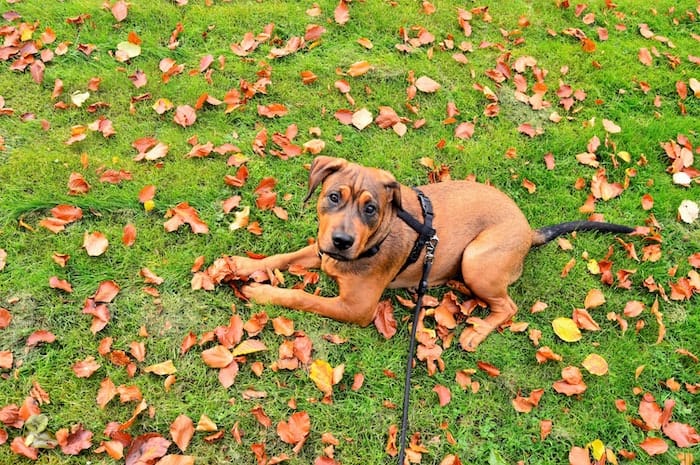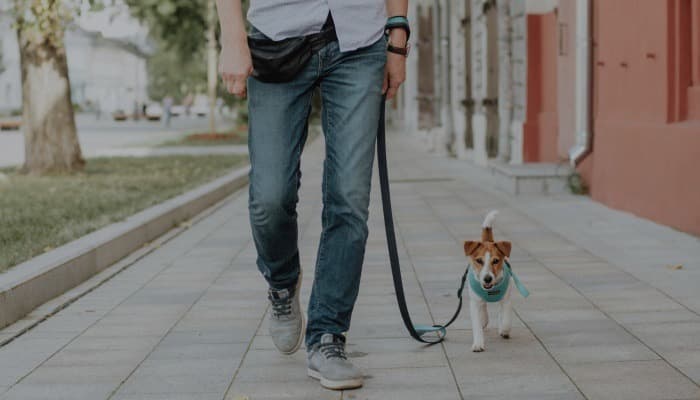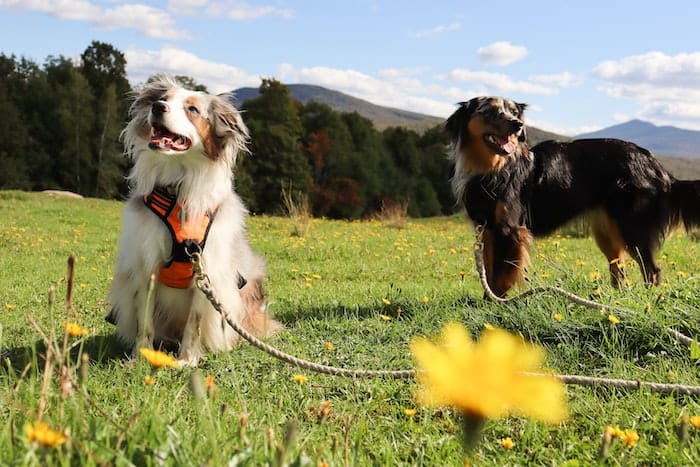Training leads are long, flexible, and adjustable leashes that allow you to control your dog’s movements and actions during training sessions.
They are useful tools for teaching your dog basic commands, improving their leash manners, and enhancing their skills and confidence.
In this article, we will explore the types of training leads, how to choose the right one for your dog, and how to use them effectively to shape your dog’s behavior.

What is a Training Lead and How Does It Work?
A training lead is a type of dog lead that has multiple purposes and functions. It is different from a standard dog lead or a long line, which are used for different scenarios. A training lead has the following features:
- It has two ends, each with a trigger hook that can be attached to different points on the dog’s collar, harness, or headcollar.
- It has two D rings and one O ring along the length of the lead, which can be used to adjust the length of the lead or create a handle for the owner.
- It is longer than a standard dog lead, but shorter than a long line, usually around 2 meters at full length.
In addition to adjustable training leads, retractable dog leads are another useful type of leash for training and walking your dog. Retractable leads allow your dog to explore and move freely while giving you control over the distance. Look for durable retractable leads that can handle your dog’s size and energy level when choosing the best retractable dog lead.
A training lead works by giving the owner more control and flexibility over the dog’s movement and behavior. Depending on how the lead is attached and adjusted, it can be used to teach the dog various skills and commands, such as:
- Walking by the owner’s side without pulling or lagging behind (loose lead walking)
- Staying close to the owner in different situations (heeling)
- Coming back to the owner when called (recall)
- Stopping and waiting on cue (stay)
- Walking or jogging with the owner hands-free (waist attachment)
A training lead can also be used to tether the dog to a secure object when needed, such as when visiting a pub or a cafe, without having to remove and reattach the lead.

Benefits of Using a Training Lead for Your Dog
Using a training lead for your dog can have many benefits, both for you and your dog. Some of these benefits are:
- It can help you train your dog more effectively and efficiently, as you can adjust the length and connection of the lead according to your dog’s level of skill and progress
- It can help you communicate with your dog more clearly and consistently, as you can use the lead to guide, correct, or reward your dog’s behavior.
- It can help you prevent or manage unwanted behaviors from your dog, such as pulling, jumping, chasing, or barking, by giving you more control over your dog’s movement and direction.
- It can help you keep your dog safe and comfortable in different environments and situations, such as busy streets, crowded places, or unfamiliar areas, by keeping your dog close to you and away from potential hazards or distractions.
- It can help you bond with your dog and enjoy your walks more, as you can use the lead to create a positive association between walking with you and getting treats, praise, or play.
Training leads are excellent tools for teaching basic manners and skills to dogs, especially rescue dogs who may not have had prior training. If you want to learn more about how to train a rescue dog, a training lead is a great place to start
How to Choose the Right Training Lead for Your Dog
There are many types and brands of training leads available on the market, but not all of them are suitable for every dog. When choosing a training lead for your dog, you should consider the following factors:
- The size and strength of your dog. You should choose a training lead that is appropriate for your dog’s weight and power. A training lead that is too thin or weak may snap or break if your dog pulls hard. A training lead that is too thick or heavy may be uncomfortable or cumbersome for your dog to wear.
- The material and quality of the training lead. You should choose a training lead that is made of durable and comfortable material that can withstand wear and tear. A training lead that is made of cheap or rough material may fray or tear easily. A training lead that is made of harsh or abrasive material may irritate or injure your dog’s skin or coat.
- The design and functionality of the training lead. You should choose a training lead that has multiple features and options that suit your needs and preferences. A training lead that has only one end or one ring may limit your choices of attachment and adjustment. A training lead that has too many ends or rings may confuse you or get tangled easily.

How to Use a Training Lead Effectively and Safely
Using a training lead for your dog requires some knowledge and practice to ensure that you use it correctly and safely. Here are some tips on how to use a training lead effectively and safely:
- Before using a training lead for your dog, make sure that your dog is wearing a suitable collar, harness, or headcollar that fits well and does not cause discomfort or injury to your dog. You should also check that the trigger hooks, rings, and clips on the training lead are secure and functional.
- When using a training lead for your dog, start with short sessions in familiar and low-distraction environments, such as indoors or in your garden. Gradually increase the duration and difficulty of the sessions as your dog improves and gains confidence.
- When using a training lead for your dog, always use positive reinforcement methods, such as treats, praise, or toys, to reward your dog for following your cues and displaying the desired behavior. Avoid using negative or aversive methods, such as jerking, yanking, or scolding, to punish your dog for ignoring your cues or displaying the unwanted behavior.
- When using a training lead for your dog, always monitor your dog’s body language and behavior, and adjust the lead accordingly. If your dog shows signs of stress, fear, or discomfort, such as panting, drooling, yawning, licking, or cowering, you should stop the session and give your dog a break. If your dog shows signs of excitement, curiosity, or aggression, such as pulling, lunging, barking, or growling, you should redirect your dog’s attention and calm your dog down.
- When using a training lead for your dog, always be aware of your surroundings and potential hazards or distractions, such as other dogs, people, cars, or wildlife. You should also be respectful of other people’s space and property, and follow the local rules and regulations regarding dogs and leads.
Training Lead Exercises and Games for Your Dog
Using a training lead for your dog can be fun and rewarding for both of you. Here are some examples of exercises and games that you can do with your dog using a training lead:
- Loose lead walking: This is the basic skill of teaching your dog to walk by your side without pulling or lagging behind. To do this, you can use the training lead to adjust the length of the lead according to your dog’s position. For example, if your dog is ahead of you, you can shorten the lead by connecting one of the triggers to the nearest ring. If your dog is behind you, you can lengthen the lead by connecting one of the triggers to the farthest ring. You can also use treats to lure and reward your dog for staying by your side.
- Heeling: This is the advanced skill of teaching your dog to walk close to you in different situations. To do this, you can use the training lead to attach both triggers to different points on your dog’s collar, harness, or headcollar.
For example, if you have a harness with a front and back ring, you can attach one trigger to each ring. This gives you more control over your dog’s chest and direction. You can also use verbal cues and hand signals to guide and reward your dog for heeling.
- Recall: This is the essential skill of teaching your dog to come back to you when called. To do this, you can use the training lead to give your dog some freedom and distance from you.
For example, if you have a secure area where you can let your dog off the lead safely, you can attach one trigger to your dog’s collar or harness and drop the other end of the lead on the ground.
You can then call your dog’s name and use treats to entice and reward your dog for coming back to you. You can also use the other end of the lead to gently guide or reel in your dog if needed.
- Stay: This is the useful skill of teaching your dog to stop and wait on cue. To do this, you can use the training lead to tether your dog to a secure object or yourself. For example, if you want to teach your dog to stay in one spot3, you can attach one trigger to your dog’s collar or harness and wrap the other end of the lead around a pole or a fence and reconnect it.
You can then give your dog a verbal cue such as “stay” and walk away from them. You can then return to them and reward them for staying in place. You can also use the O ring on the training lead to attach it around your waist1 if you want to teach your dog to stay close to you.
- Hands-free walking or jogging: This is the fun activity of walking or jogging with your dog without holding the lead. To do this, you can use the training lead to attach it around your waist1 and connect one trigger to your dog’s collar or harness. You can then adjust the length of the lead according to your speed and distance from your dog. You can also use verbal cues and hand signals to communicate with your dog while moving.
Well, That’s a Wrap
A training lead is a versatile and useful tool that can help you shape your dog’s behavior in various ways. It can help you train your dog more effectively and efficiently, communicate with your dog more clearly and consistently, prevent or manage unwanted behaviors from your dog, keep your dog safe and comfortable in different environments and situations, bond with your dog and enjoy your walks more.
Related Reading
